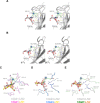Structural Basis Underlying the Binding Preference of Human Galectins-1, -3 and -7 for Galβ1-3/4GlcNAc
- PMID: 25945972
- PMCID: PMC4422656
- DOI: 10.1371/journal.pone.0125946
Structural Basis Underlying the Binding Preference of Human Galectins-1, -3 and -7 for Galβ1-3/4GlcNAc
Abstract
Galectins represent β-galactoside-binding proteins and are known to bind Galβ1-3/4GlcNAc disaccharides (abbreviated as LN1 and LN2, respectively). Despite high sequence and structural homology shared by the carbohydrate recognition domain (CRD) of all galectin members, how each galectin displays different sugar-binding specificity still remains ambiguous. Herein we provided the first structural evidence of human galectins-1, 3-CRD and 7 in complex with LN1. Galectins-1 and 3 were shown to have higher affinity for LN2 than for LN1, while galectin-7 displayed the reversed specificity. In comparison with the previous LN2-complexed structures, the results indicated that the average glycosidic torsion angle of galectin-bound LN1 (ψ(LN1) ≈ 135°) was significantly differed from that of galectin-bound LN2 (ψ(LN2 )≈ -108°), i.e. the GlcNAc moiety adopted a different orientation to maintain essential interactions. Furthermore, we also identified an Arg-Asp/Glu-Glu-Arg salt-bridge network and the corresponding loop (to position the second Asp/Glu residue) critical for the LN1/2-binding preference.
Conflict of interest statement
Figures





Similar articles
-
Mammalian galectins bind galactoseβ1-4fucose disaccharide, a unique structural component of protostomial N-type glycoproteins.Biochem Biophys Res Commun. 2013 Jul 5;436(3):509-13. doi: 10.1016/j.bbrc.2013.05.135. Epub 2013 Jun 7. Biochem Biophys Res Commun. 2013. PMID: 23751344
-
Structural basis for distinct binding properties of the human galectins to Thomsen-Friedenreich antigen.PLoS One. 2011;6(9):e25007. doi: 10.1371/journal.pone.0025007. Epub 2011 Sep 20. PLoS One. 2011. PMID: 21949831 Free PMC article.
-
Oligosaccharide specificity of galectins: a search by frontal affinity chromatography.Biochim Biophys Acta. 2002 Sep 19;1572(2-3):232-54. doi: 10.1016/s0304-4165(02)00311-2. Biochim Biophys Acta. 2002. PMID: 12223272 Review.
-
Lactulose as a novel template for anticancer drug development targeting galectins.Chem Biol Drug Des. 2018 Oct;92(4):1801-1808. doi: 10.1111/cbdd.13348. Epub 2018 Jul 1. Chem Biol Drug Des. 2018. PMID: 29888844
-
Galactoseβ1-4fucose: A unique disaccharide unit found in N-glycans of invertebrates including nematodes.Proteomics. 2016 Dec;16(24):3137-3147. doi: 10.1002/pmic.201600001. Epub 2016 Jun 8. Proteomics. 2016. PMID: 27091793 Review.
Cited by
-
Purification of Recombinant Galectins from Different Species Using Distinct Affinity Chromatography Methods.Methods Mol Biol. 2022;2442:55-74. doi: 10.1007/978-1-0716-2055-7_3. Methods Mol Biol. 2022. PMID: 35320519
-
A brief history of galectin evolution.Front Immunol. 2023 Jun 29;14:1147356. doi: 10.3389/fimmu.2023.1147356. eCollection 2023. Front Immunol. 2023. PMID: 37457740 Free PMC article.
-
Innate immune Galectin-7 specifically targets microbes that decorate themselves in blood group-like antigens.iScience. 2022 May 30;25(7):104482. doi: 10.1016/j.isci.2022.104482. eCollection 2022 Jul 15. iScience. 2022. PMID: 35754739 Free PMC article.
-
Minimizing the Entropy Penalty for Ligand Binding: Lessons from the Molecular Recognition of the Histo Blood-Group Antigens by Human Galectin-3.Angew Chem Int Ed Engl. 2019 May 27;58(22):7268-7272. doi: 10.1002/anie.201900723. Epub 2019 Apr 17. Angew Chem Int Ed Engl. 2019. PMID: 30942512 Free PMC article.
-
Intrinsic tryptophan fluorescence spectroscopy reliably determines galectin-ligand interactions.Sci Rep. 2019 Aug 14;9(1):11851. doi: 10.1038/s41598-019-47658-8. Sci Rep. 2019. PMID: 31413267 Free PMC article.
References
-
- Barondes SH, Castronovo V, Cooper DN, Cummings RD, Drickamer K, Feizi T, et al. Galectins: a family of animal beta-galactoside-binding lectins. Cell. 1994. February 25;76(4):597–8. - PubMed
-
- Leffler H, Carlsson S, Hedlund M, Qian Y, Poirier F. Introduction to galectins. Glycoconjugate journal. 2004;19(7–9):433–40. - PubMed
-
- Liu FT, Rabinovich GA. Galectins as modulators of tumour progression. Nat Rev Cancer. 2005. January;5(1):29–41. - PubMed
Publication types
MeSH terms
Substances
Associated data
- Actions
- Actions
- Actions
LinkOut - more resources
Full Text Sources
Other Literature Sources
Research Materials
Miscellaneous

